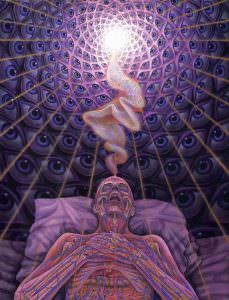Alex Grey is one of the most noted contemporary painters in America who has been involved in art with a spiritual dimension. His work is based upon the anatomy of the human body, creating disturbing images that challenge perception.
Here’s Part 2 of an interview with Alex at Damanhur.
 Alex Grey: I see Damanhur and the Temples here as a beacon and lighthouse. Through this living presence that Damanhurians have invited into their lives and have become an expression of, they look at different ways, political, ecological and economic; different systems of using creative energy, art energy and take a visionary approach to all these different aspects. If we don’t take the answers already provided for us, what can we do as a people? So the evidence of creative thinking is inspirational, I think, for everyone who looks at Damanhur. They look like they’re having a good time doing it, you know. Not only is this spirituality beautiful but also it has found a way to act through all the different arts, through dance and theatre and performance of all kinds; to costume and fashion and of course all of the stonework and sculpture, painting and glass work. I don’t know anywhere on earth where all of these arts are being practiced in such an integrated fashion. Not that theirs is any kind of ‘cookie cutter’ design element. This coordination of efforts by many independent artists pooling their minds together, expresses what is, I think, humanity’s greatest potential.
Alex Grey: I see Damanhur and the Temples here as a beacon and lighthouse. Through this living presence that Damanhurians have invited into their lives and have become an expression of, they look at different ways, political, ecological and economic; different systems of using creative energy, art energy and take a visionary approach to all these different aspects. If we don’t take the answers already provided for us, what can we do as a people? So the evidence of creative thinking is inspirational, I think, for everyone who looks at Damanhur. They look like they’re having a good time doing it, you know. Not only is this spirituality beautiful but also it has found a way to act through all the different arts, through dance and theatre and performance of all kinds; to costume and fashion and of course all of the stonework and sculpture, painting and glass work. I don’t know anywhere on earth where all of these arts are being practiced in such an integrated fashion. Not that theirs is any kind of ‘cookie cutter’ design element. This coordination of efforts by many independent artists pooling their minds together, expresses what is, I think, humanity’s greatest potential.
Damanhurian interviewer: As a visionary painter, as a visionary artist yourself, do you see any correlation between your own work and that of the work of Damanhurian artists?
Alex Grey: I see a real brother-sisterhood and a great similarity of intention. In our small way, the Chapel of Sacred Mirrors is attempting to also resuscitate or re-align people with their own potential and re-awaken spirit. That is my intent. My intent is not only to make a fantastic or beautiful vision, as wonderful as that might be; I don’t think that is what is called for at this time. All art is useful. I am a lover of arts.
On the other hand, I think that art can be put on a sacred mission at this point, as I have explained, to re-kindle our interconnectedness as a human family and to come to understanding our connectedness with nature. If we don’t re-kindle, re-awaken or awaken a reverence for life, we are in a process of self-destruction as a human race and we are shutting down the web of life by destroying so many species and not caring about the way we interact with our environment. That’s why in the Damanhurian way, the games and the laboratory, all these metaphors for interaction with each other and with the land, and finding ways of working creatively and ecologically, or at least thinking in those ways, points to a sustainable future.
I think we also need art that points in that  direction. I loved Warhol, but a Campbell soup can as an icon, to me doesn’t argue for the sustainability of the human enterprise. It’s an adoption and cooptionof creative control to the corporation. It doesn’t show the kind of battle that’s going on the the human spirit, which is so well shown in the Hall of Earth where stony personas, our sort of robotic and deadened selves are being defeated by laughter and passion. So those are the elements that I think will sustain us in our creative joy and that’s certainly what Damanhur represents to me.
direction. I loved Warhol, but a Campbell soup can as an icon, to me doesn’t argue for the sustainability of the human enterprise. It’s an adoption and cooptionof creative control to the corporation. It doesn’t show the kind of battle that’s going on the the human spirit, which is so well shown in the Hall of Earth where stony personas, our sort of robotic and deadened selves are being defeated by laughter and passion. So those are the elements that I think will sustain us in our creative joy and that’s certainly what Damanhur represents to me.
From Qui Damanhur Futuro magazine #5, January-March 2005







